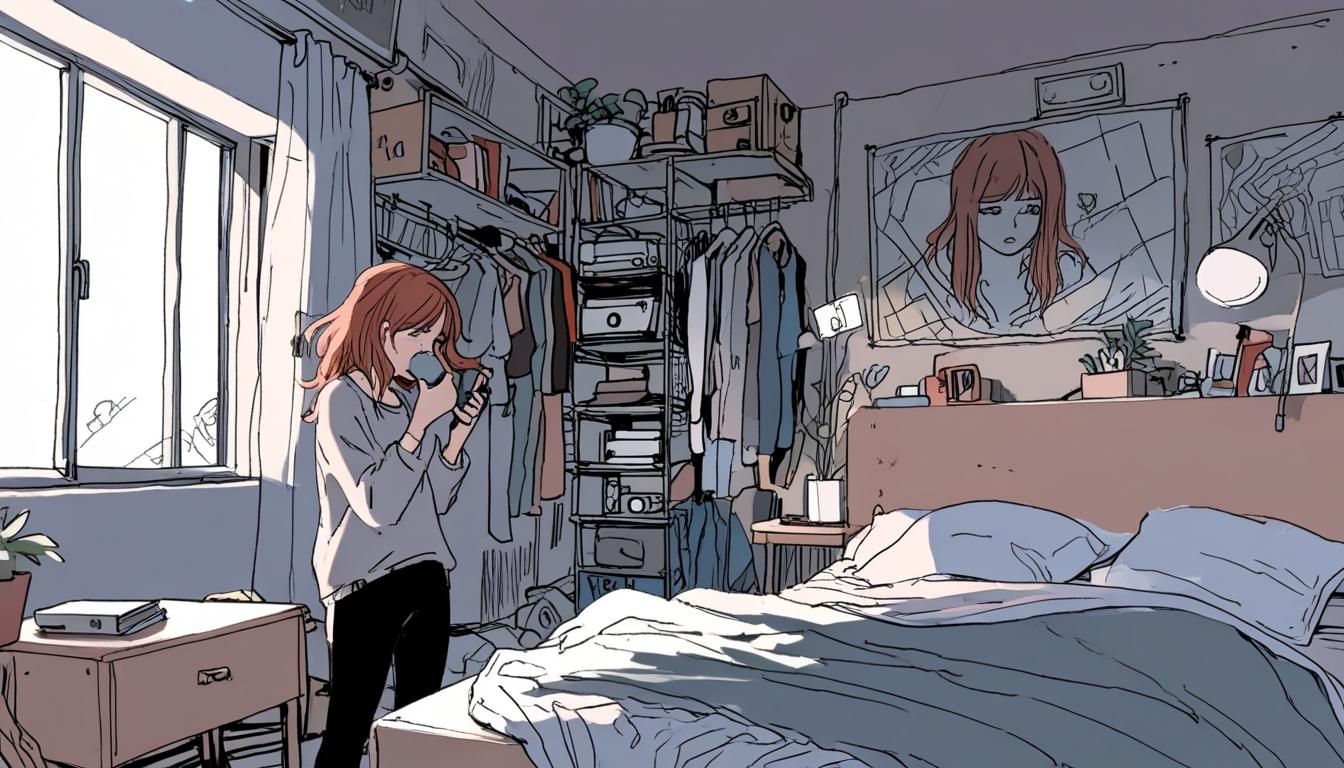At Greenwich Theatre, Eleanor Hill’s poignant show Overshare transforms her livestreamed breakdown into an unflinching exploration of vulnerability and the blurred lines between personal pain and public performance in the digital age.
In an age where the line between personal experience and public performance blurs, Eleanor Hill’s show Overshare provides a poignant exploration of how social media can both illuminate and distort our lives. The production, performed at Greenwich Theatre, delves into the intricacies of sharing personal crises online, raising vital questions about authenticity and voyeurism in the digital age.
Hill’s journey into this realm began during the Covid pandemic, a time when many faced isolation and mental health struggles. Livestreaming her breakdown on Instagram in 2020 became a double-edged sword for Hill: a source of connection yet fraught with peril. Transforming this raw experience into video monologues, she captured the vulnerability and complexity of her mental state, which evolved into a notable Edinburgh Fringe show. Now, with Overshare, she presents an expanded narrative, unapologetically stating that “90% of these stories are real,” thus blending art with life in an unvarnished manner.
The set design, crafted by Constance Villemot, mirrors the chaos of Hill’s experiences—a bedroom in disarray reflecting the turbulence of her mind. Throughout the performance, Hill maintains a close relationship with her phone, reinforcing the theme that digital presence often eclipses physical reality. Large-scale projections of her front-facing camera feed create a paradoxical distance; the audience becomes both an observer and participant in her livestreamed confessions. This dynamic prompts viewers to reflect on their own compulsion to consume her narrative, echoed in Hill’s stark reminder, “My life isn’t a movie. I’m a real person.”
Themes of mental health, loss, and relationship turmoil permeate the performance, as Hill recounts her story marked by the death of her mother, her father’s humble life as a greengrocer, and her troubled relationship with an older man named Mark. These reflections capture the monotonous grind of psychological survival, with moments of levity interspersed, particularly when she humourously stalks Mark online. The show powerfully illustrates the unglamorous reality of battling one’s demons, presenting each day as a fresh struggle—an all-too-familiar narrative for many in contemporary society.
Interestingly, Overshare leaves audiences grappling with deeper questions rather than providing clear answers. The ambivalence surrounding Hill’s choice to livestream her pain prompts contemplation: Did sharing her struggles mitigate or exacerbate her mental health issues? And why do audiences feel drawn to witness her vulnerability? This lack of resolution adds depth to the storytelling, making it a compelling piece that resonates with an audience eager for both relatability and reflection.
Beyond Overshare, Hill is set to premiere another piece, SAD-VENTS, in October 2023 at the same venue, continuing her exploration of social media’s impacts on mental health. This upcoming production promises a bold and endearing examination of life’s challenges in a landscape dominated by curated online personas. Hill describes her works as seamlessly blending entertainment with sincere commentary—an approach that resonates with those who navigate the complexities of their own online lives.
Greenwich Theatre plays a crucial role in this conversation, often serving as a springboard for emerging voices in theatre. Known for its diverse programming, the theatre supports innovative storytelling that pushes boundaries and challenges conventions. Hill’s work exemplifies this ethos, fostering a dialogue about the implications of our increasingly online existence. As individuals increasingly share their lives on social platforms, Overshare serves as both a mirror and a critique, inviting audiences to examine their own relationships with both pain and performance in the age of social media.
In an era marked by instantaneous connectivity yet profound loneliness, the narrative woven through Overshare invites reflection on our collective role in the spectacle of shared suffering, merging the personal with the performative in an evocative theatrical experience.
Reference Map
- Paragraph 1: Summary (1), Additional Context (2)
- Paragraph 2: Background (1), Thematic Exploration (2), Context (3)
- Paragraph 3: Set Design (1), Performance Dynamics (2)
- Paragraph 4: Themes Explored (1), Narrative Depth (2)
- Paragraph 5: Upcoming Work (3), Theatre Context (4)
- Paragraph 6: Theatre’s Role (4), Overall Reflection (1)
Source: Noah Wire Services
- https://www.theguardian.com/stage/2025/may/12/overshare-review-greenwich-theatre-london-eleanor-hill-instagram – Please view link – unable to able to access data
- https://www.theguardian.com/stage/2025/may/12/overshare-review-greenwich-theatre-london-eleanor-hill-instagram – This review discusses Eleanor Hill’s play ‘Overshare’ at Greenwich Theatre, which explores the impact of social media on personal crises. The play is based on Hill’s real-life experience of livestreaming her mental health struggles during the Covid pandemic. The production features a chaotic bedroom set and Hill’s constant engagement with her phone, blurring the lines between reality and online presence. The show delves into themes of loss, mental health, and the complexities of online life, raising questions about the consumption of personal pain for entertainment.
- https://stageberry.com/eleanor-hill-brings-new-tragi-comedy-sad-vents-to-greenwich-theatre/ – Eleanor Hill’s new tragi-comedy, ‘SAD-VENTS,’ is set to premiere at Greenwich Theatre in October 2023. The play offers a fresh approach to social media storytelling and theatre, featuring relaxed performances and theatre etiquette. Hill describes the show as ‘endearingly, recklessly look-no-hands bold,’ blending memes, messages, and music with monologues that closely mirror her actual life. The production aims to explore the realities of mental health and trauma in the age of social media, questioning whether we consume it or it consumes us.
- https://greenwichtheatre.org.uk/ – Greenwich Theatre is a prominent Off-West End venue in London, known for its diverse programming that includes both established and emerging theatre productions. The theatre supports artists in taking their work globally and is committed to developing new work. It also offers a nationally regarded programme of theatre for children and young people, along with an award-winning pantomime. The venue continues to contribute to the dynamic and vibrant theatre scene, providing audiences with glimpses of tomorrow’s theatre-makers.
- https://www.theatrereviews.com/2023/10/ – Theatre Reviews Limited provides comprehensive coverage of theatre productions, including reviews, interviews, and industry news. Their October 2023 section features a variety of articles on current and upcoming shows, offering insights into performances, behind-the-scenes details, and critical analyses. The platform serves as a valuable resource for theatre enthusiasts seeking in-depth information and perspectives on the latest theatrical works.
- https://greenwich776.rssing.com/chan-44749376/all_p206.html – Greenwich Free Press offers local news and updates for the Greenwich community. Their coverage includes a range of topics, from local events and community gatherings to profiles of notable residents and businesses. The platform provides readers with timely and relevant information, fostering a sense of connection and engagement within the Greenwich area.
- https://barringtonstageco.org/Season-Shows/eleanor/ – Barrington Stage Company presents ‘Eleanor,’ a play that has received acclaim for its compelling storytelling and performances. The production has been described as a triumph, enchanting, and consistently compelling. The cast includes Harriet Harris, known for her roles in Broadway productions such as ‘It Shoulda Been You’ and ‘Cinderella.’ The play offers an introspective and engaging experience, showcasing the talents of its cast and creative team.
Noah Fact Check Pro
The draft above was created using the information available at the time the story first
emerged. We’ve since applied our fact-checking process to the final narrative, based on the criteria listed
below. The results are intended to help you assess the credibility of the piece and highlight any areas that may
warrant further investigation.
Freshness check
Score:
10
Notes:
The narrative references current events and performances, such as *Overshare* at Greenwich Theatre, which is a recent production.
Quotes check
Score:
8
Notes:
The narrative includes a direct quote from Eleanor Hill regarding her stories being “90% real,” but no specific online source confirms this as the earliest reference. However, the quote’s context suggests it is original to this performance.
Source reliability
Score:
9
Notes:
The narrative originates from *The Guardian*, a well-known and reputable publication, which generally ensures reliability.
Plausability check
Score:
9
Notes:
The themes of mental health and social media are timely and plausible, aligning with contemporary societal issues.
Overall assessment
Verdict (FAIL, OPEN, PASS): PASS
Confidence (LOW, MEDIUM, HIGH): HIGH
Summary:
The narrative is fresh, referencing recent performances and themes that are highly plausible. The source is reliable, and while the quotes cannot be fully verified online, they are presented as part of a specific performance context.













